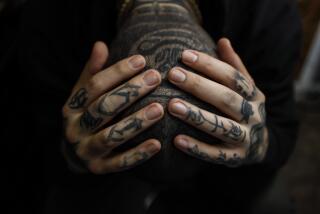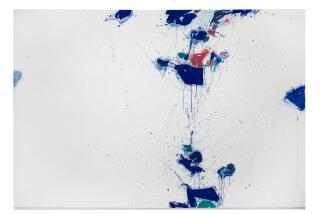Thin Ink Lines Between East, West
The story of a long, slow cultural exchange between East and West is embedded in two related traveling exhibitions at Loyola Marymount Universityâs Laband Art Gallery. âEloquent Line: Japanese Calligraphy in the 1990sâ includes examples of works by 58 artists. âHung-shu Hu: Between Tradition and Innovationâ presents a dozen canvases by a Chinese artist who emigrated to the U.S. from Taiwan in 1965.
The ancestral line of calligraphy stretches back to archeological time. Through centuries it developed from pictographic representations to ideographic signs, finally evolving into abstract symbols that function roughly the same ways as the letters of Western alphabets. Both Chinese and Japanese forms are grounded in Buddhist prototypes.
Basically, calligraphy is writing refined to the point of art. Western civilization had its own form. It dominated the production of illuminated manuscripts in the Middle Ages until German printer Johannes Gutenberg invented movable type in the 15th century. Forms of calligraphy continued to be employed in the West as long as penmanship was valued. Today hand-made calligraphy is relatively rare. Who needs it in a culture where you can buy calligraphic type faces for your computer? In Japan, by contrast, 15 million people still do calligraphy. Evidently itâs retained some of its traditional clout as a mark of personal refinement and cultivation. In addition itâs linked to the practice of Buddhism as a path to religious enlightenment.
*
An example by Kinsui Mikami is nothing more than a copy of a text of Buddhist scripture. The act, valued as a gesture of reverence, is also clearly hellishly difficult. Vertical ranks of several hundred characters in black ink are divided by white line on a red background. The page is perfect. The discipline, practice and concentration required to bring this off in a form that permits no revision is mind-boggling.
The arrival of Zen Buddhism via China in the 13th century gradually allowed calligraphy greater elbow-room for idiosyncratic expression. Curiously enough, however, Japanese calligraphers didnât get permission to be creatively autonomous until the end of World War II. By then American artists like Jackson Pollock, Franz Kline and Mark Tobey had developed Abstract Expressionism. It was drawn partly from Surrealist notions of tapping the subconscious through artistic improvisation and partly from, guess what, Asian calligraphy.
*
The principle uniting East and Western artists here was a conviction that a line or mark is eloquent independently of what it may represent as picture or letter. It speaks through the physical gesture of the artist.
A long vertical composition by Shunsen Kawakami bears two lines of calligraphy. They trail wanly downward in elegant arabesques like willow tendrils caressing water. Itâs absolutely no surprise to find the title is âUnrequited Love.â
Tankyu Sanyoâs broad, upright gesture abstracts a long tradition of Japanese frankness about phallic representation. Thereâs a hint of wistful humor in his title, âPrayer.â
Japan also has a long tradition of narrative art. Gyokurei Takezawa mixes it with abstraction and an allusion to comic animation in his âIn Step Together.â
The companion exhibition finds Chinese immigrant painter Hung-shu Hu with feet almost equally planted in East and West. That certainly has something to do with his having spent almost 30 years as a professor of design at the University of Iowa. Noted both here and in Taiwan for his furniture and lighting designs, he practices painting as a form of personal expression.
Works like âSlowly Risingâ have a monumentality that unmistakably evoke classic Chinese landscape. The surprise is that Hu seems at first to replace their lofty philosophical detachment with the subjective passion of European Romanticism.
The most modern artist he connects to is German surrealist Max Ernst with his eroding, changing surfaces. More often, however, Hu brings to mind a 19th century Symbolist like Rudolphe Bresdin. In the end, these seemingly contradictory qualities meld into the tendency of both traditions to treat landscape like a living thing, bursting with latent energy.
*
* Loyola Marymount University, Laband Art Gallery, 7900 Loyola Blvd.; through Nov. 22, (310) 338-2880.
More to Read
The biggest entertainment stories
Get our big stories about Hollywood, film, television, music, arts, culture and more right in your inbox as soon as they publish.
You may occasionally receive promotional content from the Los Angeles Times.










